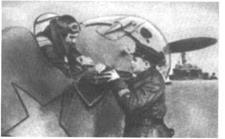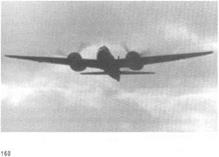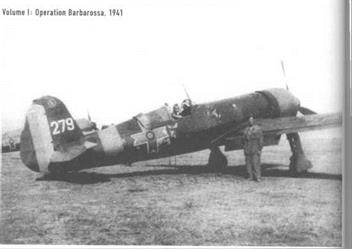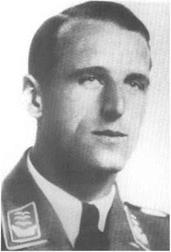. Air War Over Odessa
|
W |
hile the battle of annihilation raged in the Kiev area, a prolonged parallel battle was waged between mainly Romanian and Soviet forces for the I besieged Black Sea port of Odessa, which had been turned ї into a veritable fortress by the defenders. Most of the I Romanian front aviation—Gruparea Aeriana de Lupta B(GAL)—was concentrated at the latter battle scene. This t included the cream of the FARR: the Bf 109-equipped I Grupul 7 Vanatoare; Grupul 5 Vanatoare, outfitted with He 112Bs; Escadrila 53 Vanatoare, with Hurricanes; and I Grupul 8 Vanatoare, with Romanian-designed I. A.R. 80 I single-engine fighters. Since the Romanian assault on ^Odessa proceeded following German demands, Fliegerkorps IV allocated KG 27 Boelcke, KG 51 Edelweiss, and the Bf 109s of Major Anton Mader’s H./JG ; 77 to strengthen the initial operations. The main aim of the German Kampfgcschwadern was to neutralize Vitse-
Admiral Filipp Oktyabrskiy’s powerful fleet, which largely dominated the entire Black Sea.
Early in August 1941, only weak air forces stood at the disposal of the Odessa defenders. The main air unit in Odessa was 69 1AP, led by Mayor Lev Shestakov. As Odessa was surrounded, Mayor Shestakov could count roughly twenty operational 1-16 fighters under his command. Apart from 69 LAP, there were only three independent Black Sea Fleet aviation Eskadrilyas based at Odessa, two equipped with MBR-2 flying boats and one with SB bombers. These units were supplemented by sorties flown over Odessa by the remaining fighters and bombers of the Black Sea Fleet’s 62 LAB and 63 BAB, which were stationed in Nikolayev and the Crimea.
Mayor Shestakov’s fighters would very soon earn glowing reputation for their aggressive fight to protect the Odessa defenders from the air. Unfortunately, some
|
 The l-16-equipped 69 IAP was reinforced during the Battle of Odessa by detachments from several units of VVS-ChF. including 8 IAP. This unit achieved fame throughout Soviet Union for its performance during the bitter fight for air supremacy in the late summer and autumn of 1941. This photo shows an 1-16 pilot receiving last – minute instructions from a VVS naval kapitan prior to takeoff. (Photo: Denisov.)
The l-16-equipped 69 IAP was reinforced during the Battle of Odessa by detachments from several units of VVS-ChF. including 8 IAP. This unit achieved fame throughout Soviet Union for its performance during the bitter fight for air supremacy in the late summer and autumn of 1941. This photo shows an 1-16 pilot receiving last – minute instructions from a VVS naval kapitan prior to takeoff. (Photo: Denisov.)
of the official credits given to the undoubtedly brave men of 69 LAP seem to be based on optimistic overclaims. On August 9 (or August 8, according to another Soviet source),17 69 IAP reported a major success against a formation of Bf 109s, claiming nine shot down without loss. There are no corresponding losses registered on the
side of the Axis air forces. I1./JG 77 filed no losses on! August 8 and only two Bf 109s damaged, neither of them due to combat, on August 9. The log of the Romanian Bf 109-equipped Grupul 7 Vanatoare makes no mention of any combat losses.
The main task to the Soviet bombers in Odessa was l
tactical—to raid the Romanian ground forces and their supply lines. In doing so, they suffered heavy losses, particularly at the hands of II./JG 77. Within a short time, U./JG 77 was able to achieve air supremacy for the Axis in the skies over Odessa. In sixty-four fighter-escort and fighter-bomber sorties over the Black Sea port on August 10, the Bf 109 Gruppe claimed fifteen victories against only one loss. On top of this, these Messerschmitt pilots, experienced in antishipping fighter-bomber missions since the Battle of Crete, scored bomb hits on one light cruiser and a 6,000-ton steamer.
Shortly before noon on August 12, the Rotte composed of Oberleutnant Erich Friedrich and Leutnant Franz Hrdlicka, of II./JG 77, was on the way back to base after a fighter-bomber attack against shipping in the port of Odessa. Both had missed a "fat” 5,000-ton freighter. Suddenly they spotted three SBs. The Soviet bomber crews, belonging to 40 BAP/63 BAB, didn’t have a chance: In minutes, all three had been shot down. Oberleutnant Friedrich claimed two as his eighth and ninth victories, and Leutnant Hrdlicka claimed one as his second victory. Soviet sources confirm all three losses, listing two SBs force-landing in Soviet-held territory and the third close to enemy lines. The navigator and the
gunner of the latter made it back to Red Army positions while the pilot was captured by Romanian soldiers.
Later that day, one II./JG 77 pilot, Oberfeldwebel Eugen Wintergest, claimed what would become a rather famous act. As he returned from a single-plane test flight, he stunned his comrades by rocking seven victory signs with the wings of his Bf 109. Upon landing, Wintergest was surrounded by enthusiastic ground-crew personnel and pilots, whom he told of how he had come across nine “Martin bombers” (the incorrect German designation for the SB early in the war) and had shot down seven. Hauptmann Anton Mader, the Croatian-born veteran Gruppenkommandeur, was not so sure about the young NCO’s story, so he flew to the area where Wintergest had reported his success. To his amazement, he actually found seven bomber wrecks on the ground in the area Wintergest had designated.18 Subsequently, all seven victories were officially confirmed as Wintergest’s eighth through fourteenth victories.

Soviet sources note that six SBs, all belonging to 40 BAP, were lost in the same area on this day, including the three downed by Friedrich and Hrdlicka at noon. At about the same time that Wintergest reported his spectacular successes, 1 Eskadrilya/40 BAP reported three
|
|
Hauptmann Anton Mader was appointed Gruppenkommandeur II,/JG 77 in June 1941. Under his leadership, II./JG 77 would claim nearly four hundred victories by December 1941. Mader was an extremely popular unit commander who became famous for paying great attention and care to each of his subordinates. He survived the war with a personal score of eighty-six victories. (Photo: Bundesarchiv.)
SBs lost in combat with a Bf 109, probably Wintergest’s. There may be gaps in the Soviet loss files on this particular date, but the bomber wrecks seen by Hauptmann Mader could also have been the remnants of both air combats on this day.
Meanwhile, the bombers of the Black Sea Fleet continued to carry out their small-scale strategic air offensive against Romania. An attempt was made on August 10 to interrupt traffic across the important Danube bridge at Cernavoda, connecting the port of Constanta with the interior. The attack was conducted in three waves: Five DBAs from 2 MTAP, in the first wave, and six Pe – 2s from 40 BAP, in the second wave, failed to strike the target decisively, but six I-16SPB Zvenos from 32 LAP damaged nearby oil pipelines.
On August 13, three TB-3 Zvenos took off from Yevpatoria in the Crimea at 0330 hours. Two hours and ten minutes later, the six I-16s were released ten miles off the coast. They came diving down on the bridge, caught the defenders totally by surprise, and placed five FAB-250 bombs directly on the span. The bomb damage caused considerable disturbance to the road and railway traffic across this bridge and destroyed the nearby oil pipelines. During the return flight, the six l-16s strafed a Romanian infantry column and finally landed at Odessa Airdrome at 0705 hours. Later that day they returned to Yevpatoria, where the 1-16 Zveno commander, Kapitan Arseniy Shubikov, became the first in VVS-ChF to be awarded the Lenin Order.
But all the efforts of the airmen of VVS-ChF could not hold the numerically superior enemy back. On August 13, Odessa was completely surrounded.
At this point, the Luftwaffe raids against supply shipping to the beleaguered port were intensified. On August 13, II./JG 77’s Fahnenjunker-Gefreiter Gunther Marschhausen, who had won the competition of the day on August 10 by downing three Soviet fighters, was killed by a direct AAA hit while attacking shipping off Odessa. During an attack on a Soviet ship convoy between Odessa and Sevastopol on August 15, a Ju 88A piloted by Lcutnant Heinz Unrau of 3./KG 51 was recorded lost through ramming by a Soviet fighter.14 Extraordinarily, there is no mention of any taran in this area in the Soviet records.20
To strengthen air support to the defenders, the ll-2s of Mayor Mikhail Kravchenko’s 46 OShAE from the small WS-Pinsk Flolilya, originally aimed at the protection of naval operations on the Pripyat and Dnieper rivers, were flown in to Odessa. During the following days this unit suffered heavily in close-support missions over the front lines. Shortly afterwards the small VVS forces in Odessa were also joined by three Yak-Is from 32ІАР/ 62 IAB and four I-15bis from 94 OIAE.
The deteriorating situation forced the Zveno units to be deployed in tactical missions. 32 IAP/ChF and 63 BAB carried out their final strategic Zveno mission on August 17, scoring bomb hits on three ships in the Romanian port of Constanta. At least one 1-16 SPB was claimed shot down by I.(J)/LG 2.
On August 18 KG 27 and KG 51 reportedly sank or damaged more than thirty’ thousand tons of shipping during a single raid on Odessa. KG 27 was reported to have sunk eight transport ships totaling thirty-six thou-
 |
sand tons, and an additional twenty-four ships were damaged between August 11 and August 18. A bomber crew that single-handedly managed to sink a 10,000-ton freighter off Odessa achieved the greatest individual success. Shortly afterward, the commanders of II. and 111./ KG 27 Boelcke, Hauptmann Reinhard Gunzel and Hauptmann Hans-Henning Freiherr von Beust, were awarded Knight’s Crosses.
One of the few losses suffered by 11./JG 77 in air combat occurred on August 18, when an 1-16 from 69 IAP shot down a Bf 109 of 6./JG 77. Three days later, Unteroffizier Wolfgang Polscher, of 6 Staffel, was shot down by an 1-153 and eventually machine-gunned by the Soviet fighter as he hung in his harness.
The effectiveness of the fighter escort provided by IL/JG 77 is demonstrated by the fact that KG 27 lost only four He Ills during the month of August 1941. The contrast to the poor showings by the Romanian air men is evident. On August 21, the Bf 109-equipped Grupul 7 Vanatoare was engaged by the 1-16s of 69 IAP, which were escorting a small group of Il-2s against Romanian ground positions. Locotenent Comandor Alexandru Popisteanu, the unit leader, was lost.
Having scored fifty-four kills in the air over Odessa, II./JG 77 left this sector for the southern Dnieper area on August 28. This proved to be a turning point in the air-war situation over Odessa. Following the departure of the experienced airmen of this Jagdgruppe, the Soviet fighters in Odessa made a frantic effort to gain air superiority. A series of stiff air combats followed, with severe losses on both sides. On August 28, air combat over Odessa claimed the lives of 69 LAP’s Leytenant Vitaliy Topol’skiy, victor in eight combats (including four shared kills), and Mladshiy Leytenant Ivan Berishvili of 81АР/ ChF. Berishvili died ramming a Romanian PZL P. ll fighter at treetop level. Next day, Starshiy Politruk Semyon Kunitsa (69 LAP) was shot down by a Romanian Bf 109. Kunitsa bailed out, but he came under fire from the ground and was killed.
GAL—counting ninety-one operational aircraft on September 221—proved unable to maintain the air supremacy achieved earlier with support of 1I./JG 77. During the first days of September, the Soviets gradually took control of the air over Odessa. This further increased the difficulties faced by the beleaguered Romanian Fourth Army. A large part of at least twenty Romanian aircraft

 shot down during the Battle of Odessa22 fell victim to the fighter aces of Mayor Lev Shestakov’s 69 IAP. Lev Shestakov was credited with the destruction of eleven enemy aircraft (including eight shared victories) by mid-September 1941.
shot down during the Battle of Odessa22 fell victim to the fighter aces of Mayor Lev Shestakov’s 69 IAP. Lev Shestakov was credited with the destruction of eleven enemy aircraft (including eight shared victories) by mid-September 1941.
Among other successful pilots of 69 IAP were Kapitan Yuriy Rykachyov, with three personal and eleven collective victories by the end of September. Kapitan Mikhail Astashkin (four personal and six collective kills), and Kapitan Konstantin Denisov of 8ІАР/ChF. Kapitan Denisov managed to destroy one Ju 88 in the moonlight on the night of August 29- 30, followed by an He 111 the next day.
Soviet soldiers found both wrecks. (Three months later, fighting over the main Crimean port of Sevastopol, Denisov shot down a Ju 87. The German pilot, who bailed out and was captured, asked the Soviet soldiers if he could meet the pilot who had shot him down. He was introduced to Denisov and handed over his flight pistol. From then on, Denisov never flew a combat mission without this German weapon.)25
Kapitan Mikhail Astashkin was killed near Odessa on September 14. Having shot down a Ju 88 (probably from Stab 1II./KG 51) as his tenth victory (four personal and six collective kills), Astashkin was bounced by – two Romanian Bf 109s. Following the example of several other Soviet airmen, Astashkin reportedly crashed
his burning fighter into a concentration of enemy troops. He was posthumously awarded the title Hero of the Soviet Union.24

 |
On the night of September 21-22, the Soviet Black Sea Fleet made a surprise troop landing behind the Romanian lines at Grigorevka, west of Odessa. All available Soviet aircraft in Odessa were dispatched to neutralize the enemy air force in the area. The captured pilot of a Romanian PZL P. ll shot down by 69 LAP’S Batalyonnyy
Komissar Nikolay Verkhovets on September 21 had revealed that the Stukas of IlI./StG 77 had been called in to this sector again. Led by Mayor Shestakov, twenty l-16s from 69 1AP strafed the supposed Stuka bases at Beltsy and Baden on September 22, claiming twenty enemy aircraft put out of action on the ground for the loss of one 1-16. Meantime, the fighters of 69 1AP and VVS – ChF managed to drive the Romanian airmen from the skies above the landing grounds, claiming twelve Axis aircraft shot down during the following three days. But the attempt to cripple StG 77 on the ground failed, with disastrous results to the Soviets. According to Luftwaffe loss statistics, not a single Ju 87 of IIL/StG 77 was destroyed during the Soviet air-base raids on September 22. By sinking the destroyer Frunze plus one gunboat and a tug, and damaging the destroyers Bezuprechnyy and Besposhchadnyy, the Stukas managed to seal off the invasion force. Hauptmann Helmut Bode, the Gruppenkommandeur of Hl./St. G. 77, was awarded with the Knight’s Cross shortly afterwards.
While the two Zveno units had been shifted to tactical missions, the DBA DB-3s based in the Crimea contin
ued to carry out small raids against Romania on an almost daily basis throughout the summer and most of the fall. Constanta withstood a total of thirty-four day raids and twenty-five night raids, mostly of a nuisance character. The most successful raid was carried out on October 9, when the oil pipeline at Cernavoda was once again heavily damaged. It was not until the German offensive against the Crimea began in the fall of 1941 that these air attacks diminished considerably. When Odessa and the Crimea finally fell into German and Romanian hands, these air attacks finally ended.

Early in October, as the German pressure on the Crimea mounted, the Soviets decided to give up Odessa and transfer its garrison to the defense of Sevastopol. Vitse-Admiral Oktyabrskiy launched the entire Black Sea Fleet in an impressive Dunkirk-like evacuation. Despite relentless enemy air attacks against the evacuation fleet, 350,000 soldiers and civilians, and 200,000 tons of materiel were ferried to Sevastopol. The last defenders in Odessa were either killed or captured on October 14. A final Soviet air raid against Constanta was flown on October 15.
During the bomber offensive against Romania from June 22 to October 15, 1941, the German fighter units operating in this area—I.(J)/LG 2, I1I./JG 52, and Erganzungsgruppe/JG 77—claimed to have shot down fifty-five aircraft.25 The last air combat over Odessa was fought on October 18, as Romanian fighters shot down two MBR-2 flying boats on a reconnaissance mission.
The sixty-four-day-long siege of Odessa proved to be extremely costly to both sides. About 100,000 Romanian soldiers were either killed or injured, while on the Soviet side, 16,578 Red Army and Black Sea Fleet soldiers were reported killed or missing, with another 24,690 injured.
Soviet airmen engaged in the defense of this port had demonstrated an outstanding ability to fight an effective defensive battle. 69 LAP. earned a reputation that would last throughout the war. This unit was credited with ninety-four enemy aircraft and three transport gliders shot down between June 22 and October 14, the highest claims made by any VVS regiment during that period. After being pulled out of combat to convert to LaGG-3s after the Battle of Odessa, twelve 69 LAP pilots were made Heroes of the Soviet Union at the same time.
Although several loss records for the Soviet air units in Odessa appear to have been lost during the evacuation, the 144 aerial victories claimed by the Romanian airmen between August 29 and October 16 must be considered a large exaggeration. A Romanian evaluation eventually also concluded that the claim figures over Odessa were highly inflated. As a consequence, the High Command of the FARR issued new’ and sharpened demands for approving confirmation of aerial victories,26 While the Bf 109s of H./JG 77 had confirmed the superiority of the German fighter arm against the Soviets, the FARR had produced modest results. This is an indication of the long years of combat experience enjoyed by the German pilots—an advantage absent among the Romanian airmen—as the main factor behind the superiority of the Luftwaffe airmen against their VVS counterparts.
After the Battle of Odessa, the number of serviceable aircraft of the Romanian GAL was down to one – fifth of its original strength. With the exception of three liaison squadrons, GAL was withdrawn from first-line service after the Battle of Odessa.












